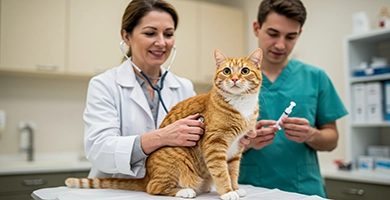
Introduction: Why Regular Vet Visits Matter for Your Cat
Many cat owners believe that a visit to the vet is only necessary when their pet is sick. However, regular check-ups play a crucial role in ensuring your cat’s long-term health and well-being. These visits help monitor weight, nutrition, vision, reflexes, and reproductive health—covering all aspects of your feline friend’s life.
If your cat shares a home with other pets, such as dogs or small animals, vet check-ups become even more essential. Preventative care can help detect potential health issues early, ensuring a longer, happier life for your furry companion.
So, how often should you take your cat to the vet? Let’s break it down based on age, lifestyle, and health status.
How Often Should You Take Your Cat to the Vet? (By Age & Health Status)
The frequency of vet visits depends on your cat’s life stage and overall health condition. Here’s a general guideline:
1. Kittens (0-12 months old): Every 3-4 weeks
Kittens require frequent vet visits to:
- Receive essential vaccinations (rabies, feline distemper, etc.).
- Get deworming treatments.
- Monitor growth and overall development.
- Begin spaying or neutering discussions.
2. Adult Cats (1-7 years old): Once a Year
Healthy adult cats should visit the vet at least once annually for:
- A full physical examination.
- Dental health check-ups.
- Vaccination boosters.
- Flea, tick, and parasite prevention.
3. Senior Cats (7+ years old): Twice a Year
As cats age, they become more prone to chronic conditions such as arthritis, kidney disease, or diabetes. Semi-annual check-ups help:
- Detect early signs of age-related illnesses.
- Monitor weight loss or gain.
- Adjust diet and supplements as needed.
4. Cats with Pre-existing Medical Conditions: As Recommended by Your Vet
If your cat has a known health issue, such as diabetes or heart disease, your veterinarian may recommend more frequent visits to monitor their condition and adjust treatments accordingly.
What Happens During a Routine Vet Visit?
A typical check-up includes:
✔ Weight monitoring – Sudden weight gain or loss can indicate underlying health issues.
✔ Dental check-up – Gum disease and tooth decay are common in cats.
✔ Eye and ear examination – Detecting infections or vision problems.
✔ Heart and lung assessment – Listening for abnormalities.
✔ Nutritional evaluation – Ensuring your cat is getting the right diet.
✔ Parasite prevention – Checking for fleas, ticks, and worms.
Many cat owners underestimate the importance of these exams, but early detection of medical conditions can save both lives and expensive treatments down the road.
Special Cases: Indoor Cats vs. Outdoor Cats vs. Multi-Pet Homes
Your cat’s lifestyle also impacts how often they should see the vet.
Indoor Cats: Once a Year
Indoor cats are generally healthier and less exposed to diseases, but they still require yearly check-ups for weight management, dental health, and vaccination updates.
Outdoor Cats: Twice a Year or More
Outdoor cats face higher risks of infections, parasites, injuries, and exposure to toxins. Bi-annual vet visits help detect and treat potential health problems early.
Multi-Pet Homes: Extra Care Needed
If your cat shares a space with other animals, such as dogs, rabbits, or hamsters, regular vet visits become even more critical. Cross-species infections and behavioral stress can affect their health. Based on personal experience, ensuring that all pets are up to date on vaccinations and routine exams helps prevent outbreaks of illness within a household.
Signs That Your Cat Needs an Immediate Vet Visit
Beyond routine check-ups, there are times when your cat may need urgent medical attention. Watch for these warning signs:
🚨 Sudden weight loss or gain – Could indicate diabetes, thyroid issues, or organ failure.
🚨 Loss of appetite for more than 24 hours – May signal digestive issues or infections.
🚨 Frequent vomiting or diarrhea – Could be caused by parasites, poisoning, or disease.
🚨 Lethargy or unusual hiding behavior – Often a sign of pain or discomfort.
🚨 Labored breathing or coughing – May indicate respiratory infections or heart problems.
🚨 Changes in urination habits – Straining, blood in urine, or excessive thirst could mean kidney disease or urinary tract infections.
If your cat exhibits any of these symptoms, don’t wait for the next scheduled visit—seek veterinary care immediately.
How to Reduce Vet Visit Stress for Your Cat
Many cats dislike car rides and unfamiliar environments, making vet visits stressful. Here are some tips to ease the process:
🐾 Use a comfortable carrier – Ensure it’s well-ventilated and lined with a soft blanket.
🐾 Familiarize your cat with the carrier – Leave it open at home so your cat gets used to it.
🐾 Cover the carrier with a towel – Helps reduce visual stress during the trip.
🐾 Choose a cat-friendly vet clinic – Some clinics specialize in feline care and use calming techniques.
🐾 Reward your cat afterward – Offer treats or affection to create a positive association.
Conclusion: The Key to a Healthy and Happy Cat
Regular vet visits are not just for sick cats—they are essential for preventative care and ensuring your cat’s long-term well-being.
By scheduling check-ups based on your cat’s age and lifestyle, monitoring for warning signs, and reducing stress during visits, you can help your feline friend live a healthier, happier, and longer life.
So, when was the last time your cat saw the vet? If it’s been more than a year, now’s the time to book an appointment! 🐱💙